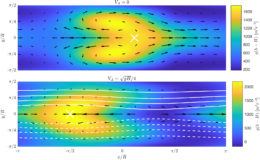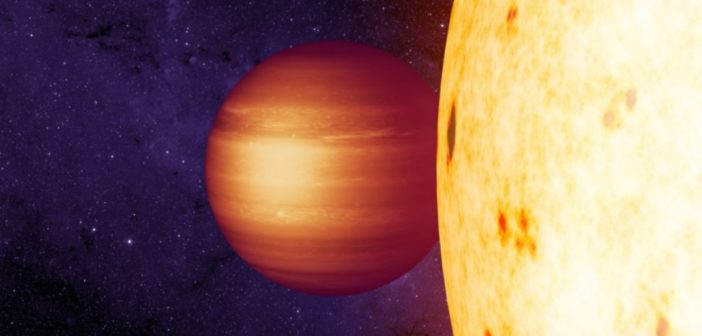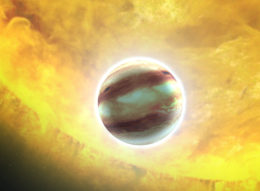Exoplanets HAT-P-7b and CoRoT-2b have an unusual quirk: instead of having eastward equatorial winds, like the majority of hot Jupiters, these two hot Jupiters have westward winds. A new study explores whether magnetic fields cause this odd reversal.
Blowing the Wrong Way
You might think that the hottest — and therefore brightest — part of a tidally locked hot Jupiter should be the part that directly faces its nearby host star. Surprisingly, our observations of hot Jupiters have generally revealed an offset for the peak brightness that’s slightly east of the point directly facing the host. These observations suggest that hot Jupiters host strong eastward-blowing winds near their equators that can displace their hottest point.Two planets break this rule, however: HAT-P-7b and CoRoT-2b. Observations of both of these hot Jupiters instead reveal hotspots that lie west of the point facing the host. Astronomers have generally interpreted this to imply that these two planets have westward-blowing equatorial winds — but why?
There are a number of proposed explanations for this odd apparent reversal:
- The planet may not be tidally locked as expected; if it rotates on its axis slightly slower than it orbits its host, this could drive westward winds.
- The apparent offset hotspot location could be an illusion caused by asymmetric cloud distribution.
- Interactions of the planet’s magnetic field with its atmosphere could modify its wind pattern.
In a new study led by Alexander Hindle (Newcastle University, UK), a team of scientists explores the feasibility of this third option.
Magnetic Waves

Plot of the geopotential, which traces temperature, in the authors’ simulations, with (bottom) and without (top) the presence of magnetic fields. The hotspot (marked with a white cross) displaces to the east for the hydrodynamic case and to the west for the magnetohydrodynamic case. [Hindle et al. 2019]
The authors next calculate the minimum magnetic field strength needed to create this equatorial wind reversal for planets with the properties of HAT-P-7b and CoRoT-2b. They find that an inflated hot Jupiter like HAT-P-7b would need a field strength above just 6 Gauss (for comparison, the Earth’s magnetic field is ~1 G). Estimated field strengths for inflated hot Jupiters lie in the 50–100 G range, so attributing HAT-P-7b’s wind reversal to magnetic fields is well within reason.
For an ordinary hot Jupiter like CoRoT-2b, however, a field strength of 3,000 G is needed. The maximum expected field strength for a hot Jupiter like CoRoT-2b is 250 G, which isn’t sufficient to drive the reversal. Hindle and collaborators conclude that a different mechanism is likely at work on this planet.
More observations of hot Jupiters in the future — as well as three-dimensional simulations — will help us to further understand the wind behavior in the atmospheres of these toasty planets.
Citation
“Shallow-water Magnetohydrodynamics for Westward Hotspots on Hot Jupiters,” A. W. Hindle et al 2019 ApJL 872 L27. doi:10.3847/2041-8213/ab05dd



1 Comment
Pingback: A Bare Hot Rock with No Atmosphere | astrobites